Quilting with Flannel: Tips of the Trade
I love quilting with flannel. So soft. So snuggly. So many different plaids! But quilting with flannel can get a little tricky because of a few of flannel’s hidden quirks.
Here’s what flannel’s putting on its online dating profile: I love to snuggle by the fire on a chilly evening with hot apple cider.
But here’s what it’s leaving out: I don’t always get along with sewing machines, and I suffer from serious shrinkage.
We get it, flannel. No one reveals all of their baggage on the first date. But if you’re going to make a big commitment together, you know, like sewing a quilt, we’re going to need some honesty.
Sure, flannel has some skeletons in the closet, but that doesn’t mean that quilting with flannel is not an option. The more you know… the better you get at quilting with flannel. Consider this your “Quilting with Flannel PSA.”
Trending patterns!
Read More From Our Quilty Adventures!
Above is the New Horizons quilt pattern. Get it here in the shop! I used peach Shetland flannel for the backing and binding.
Quilting with Flannel Episode 1: So, flannel, what’s your deal?
Flannel has been around forever. You may remember it from your childhood pj’s to that awesome well-worn shirt you had throughout high school, then college...then the first ten years after college...(whatever happened to that shirt?!)
Flannel fabric is a softly woven cloth made from wool, cotton, or synthetic fibers. How does flannel get so soft? Here’s its secret: part of the flannel-making process is using a fine metal brush to raise some of the cloth’s fibers (usually only on one side), napping it up a bit, and really upping flannel’s fluffy feel.
Quilting with flannel is an obvious fan favorite because of this softness and warmth, but just like quilting with any new fabric, it’s good to know what you’re working with before you really get going. This is especially true when quilting with flannel. Stay with us.
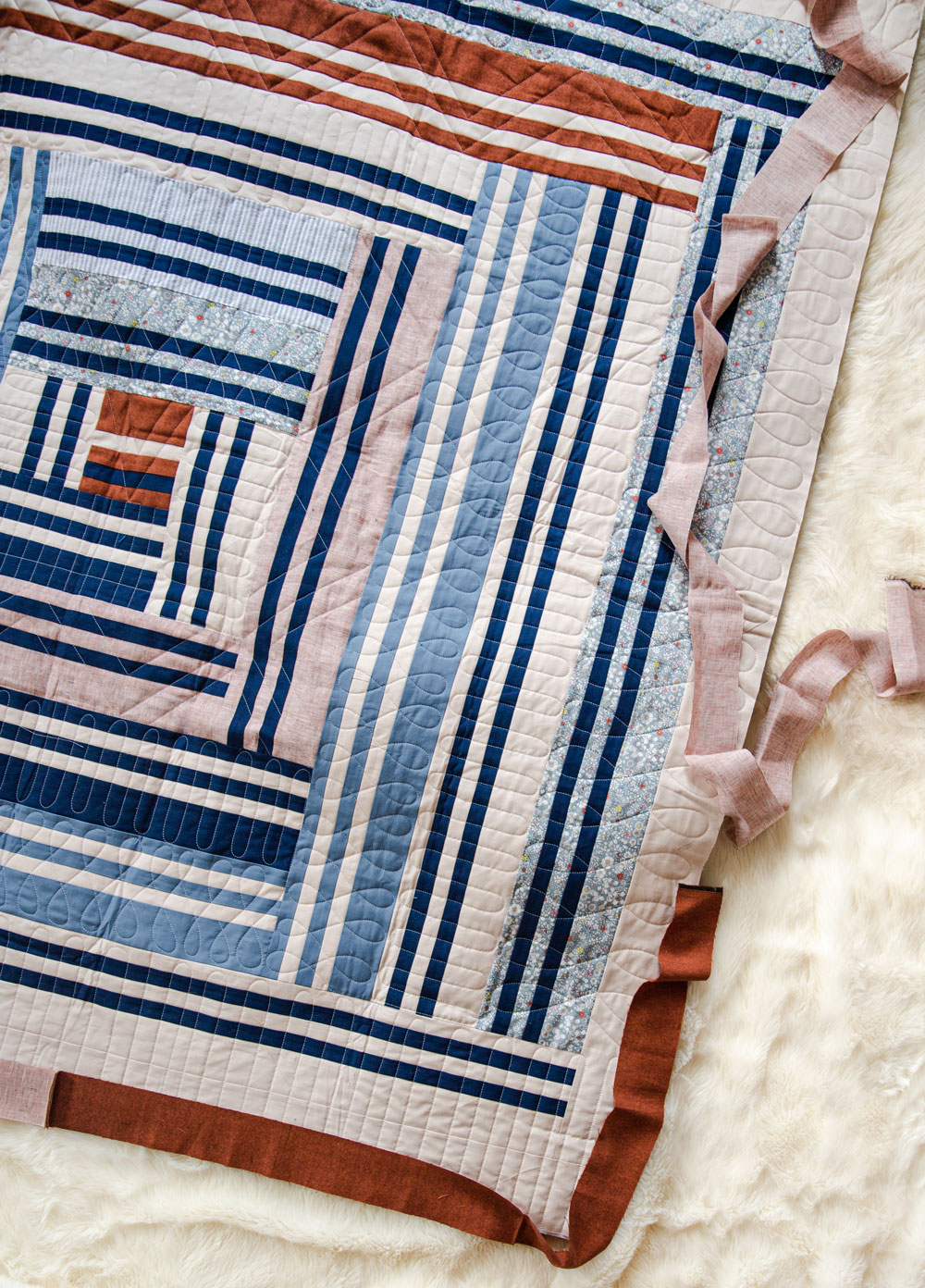
Above is the Grow quilt pattern. Get it here in the shop! I used russet herringbone Shetland flannel in some of the piecing and also some of the binding.
Quilting with Flannel Episode 2: If you’ve met one, you have NOT met them all.
Not all flannel is created equal. Flannel quality varies a ton, depending on what you buy. High priced flannel is often double-sided, washes and wears well, and shrinks and frays a little less. But listen. I know we all go for the lower-priced options sometimes. So if you’re going to be quilting with bargain flannel, know what you’re in for.
Low-qual flannel usually has a pretty low thread-count. That means that even though it’s soft and cuddly, even one wash can pill that baby up.
Lower quality flannel can come with distorted plaid as well. WHAT?! Distorted plaid? I hate distorted plaid! I know. I feel you. So don’t say I didn’t warn you. Flannel is already woven pretty loosely, making it a delicate fabric to work with. If you’re going to be ripping out some seams in preparation for quilting with flannel, rip with care… if that’s a thing? Otherwise, you might end up with a few holes.
Quilting With Flannel Episode 3: Gettin’ Ready
When you’re prepping for your big date with flannel, you’re going to want to add a few extra steps. It all starts when you meet at the fabric store… or wherever you go to purchase your flannel. Most often this fuzzy fabric comes in narrower rolls. Definitely something to keep in mind, though if you’re quilting with smaller pieces, you may not mind too much. You’re also going to be glad that flannel runs on the less-expensive end of the spectrum, because you usually have to buy more than you planned on buying. Here’s why:
- Flannel shrinks. A lot. So when you take your fabric home and pre-wash it (more on that in a minute) it’s going to come out of the dryer smaller than it was when you put it in. This means you’ll have to buy more in the first place.
- Flannel frays. Those loosely-woven fibers that give you that soft and cuddly feel also come apart easily on the edges. Because of this, you’re going to want to increase your seam allowance when quilting with flannel, from the typical 1/4" all the way to 1/2". This usually means purchasing up to a quarter yard more, but trust me. It’s worth it. You’re worth it.
After you make it home with your brand-new flannel, you’ll definitely want to pre-wash it. Use very mild detergent, and crank up your water temp so you can get all that shrinking out of the way before you start quilting with flannel.
You may want to use a lingerie bag to cut down on that fraying problem. Some I even recommend washing it twice. Drying is the same story: crank up the heat! Tip – If you want, add a large bath towel into the dryer to keep the yardage from twisting and accumulating unwanted wrinkles.
If things do get a little wrinkled, it’s not a bad idea to iron things out before sewing. Except… maybe don’t actually iron it. Since flannel is really stretchy, ironing can stretch out the fabric a little too much. Try pressing flannel instead (holding the iron in place for a few seconds), or even trying starch. Because of all of that stretchiness, flannel can slide a bit, making it hard to sew. (Have questions about starch? Read about it here, Fabric Starch: Get it or forget it?
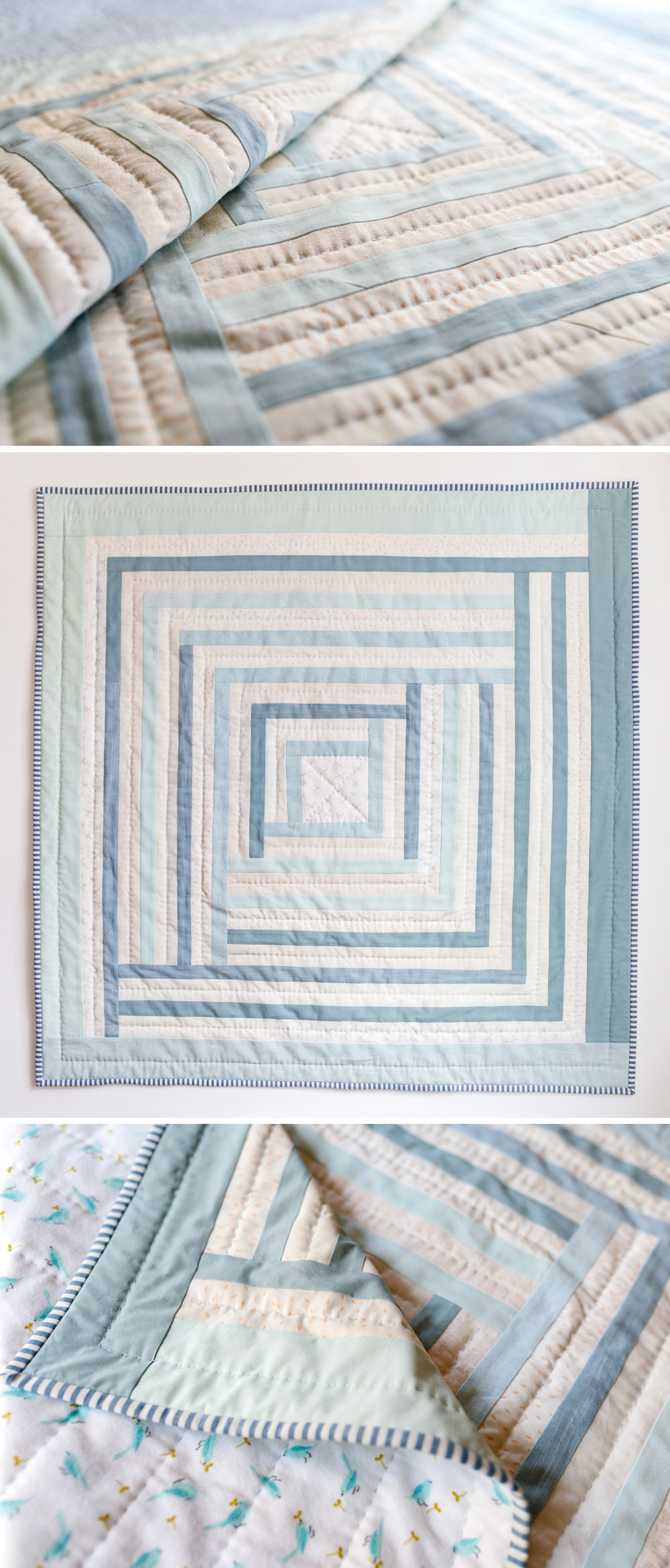
Above is the Campfire quilt pattern. Get it here in the shop!
Quilting With Flannel Episode 4: It’s Business Time
You have to pardon the Flight of the Conchords reference. I can't help myself 😉
Pre-gaming is over. You’ve pre-shrunk and straightened-up your fabric. It's time to get to work. Because flannel is a thicker, softer fabric, quilting with flannel is kind of hard on your hardware. Use sharp scissors, or a larger blade rotary cutter (2-inch diameter) when cutting. Arm your sewing machine with a new, 80/12 or even 90/14 machine needle if you have one.
As far as stitch length goes, try making them a bit longer than if you were quilting with light-weight quilting cotton. It will give you a great seam, since a shorter stitch could stretch the flannel fabric (also, if you happen to make a mistake, it’ll be easier to pick open the seams. It’s ok. We all do it.)
Lastly, I know I'm always harping about this, but use a walking foot on your sewing machine when quilting with flannel. Yes, this has to do with all of that stretching we’ve been talking about. We gotta hand it to you, flannel, you are flexible.
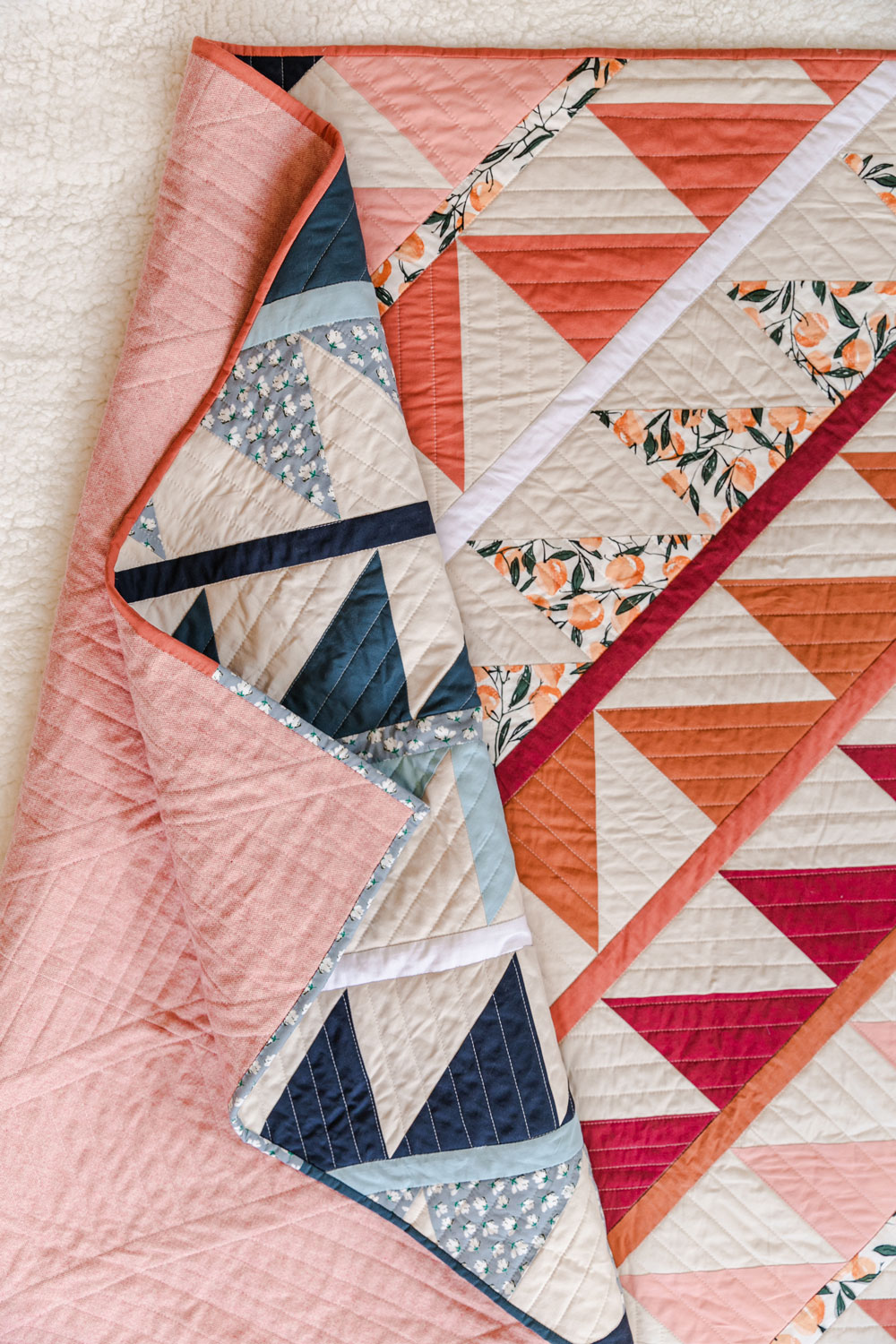
Above is the Gather quilt pattern. Get it here in the shop! I used the same peach Shetland flannel as I did with the New Horizons quilt above.
Quilting With Flannel Episode 5: The Morning After
Chances are, after a serious quilting sesh with flannel, things got a little dirty. It's the looser weave that produces all of that lint. A simple fix is to clean out the bobbin, and also around the needle after you are finished with your flannel project. I really like using this compressed gas duster for the small back corners.
And that’s it! That’s the end of your “Quilting With Flannel PSA.” Will there be a second date? That’s for you to decide. Share your experiences (and any other tips you have) in the comment section below!
*The adorable flannel photo above was taken by High Five For Love and used with permission.
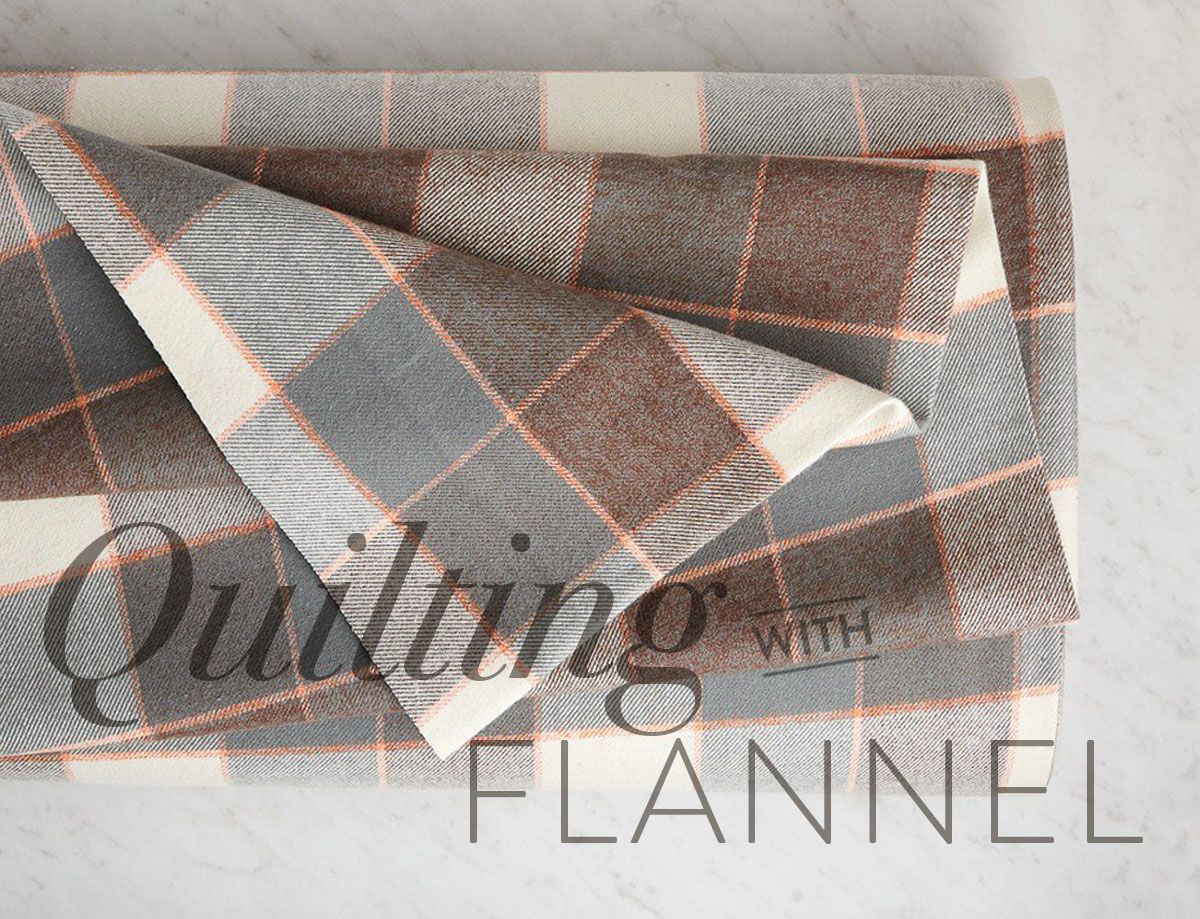
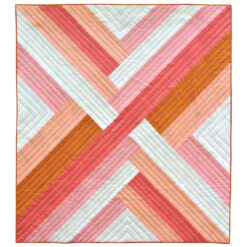
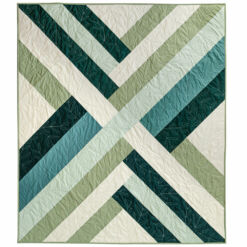
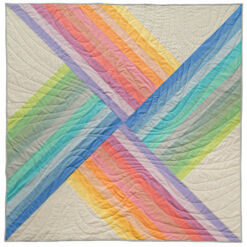
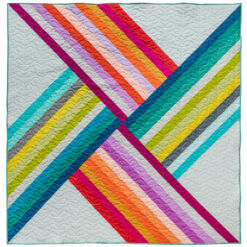
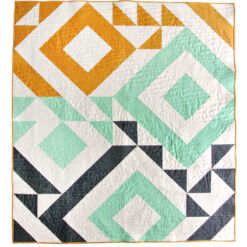
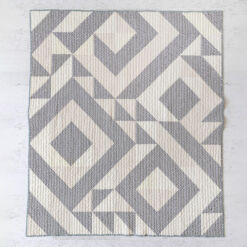
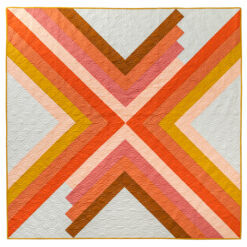
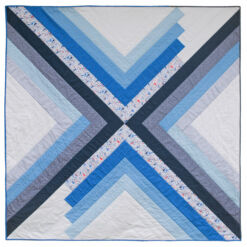
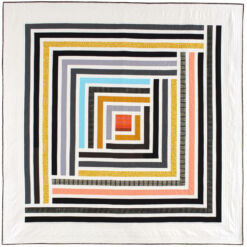
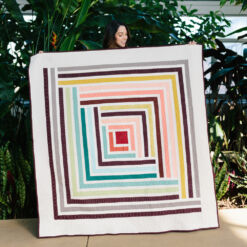
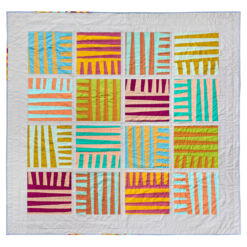
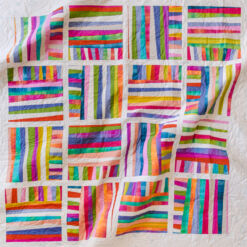
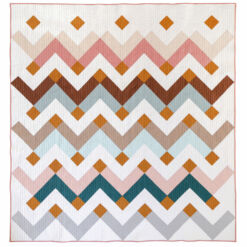
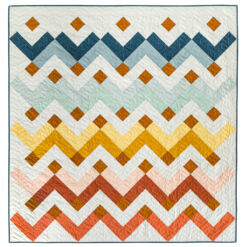
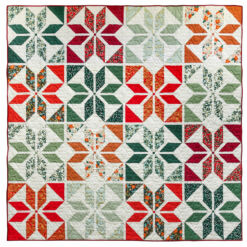
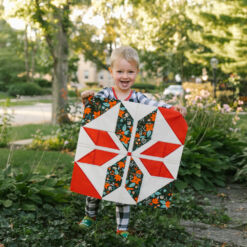
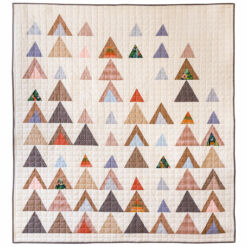
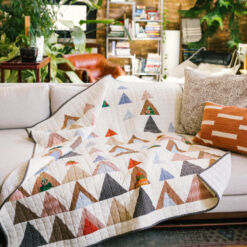
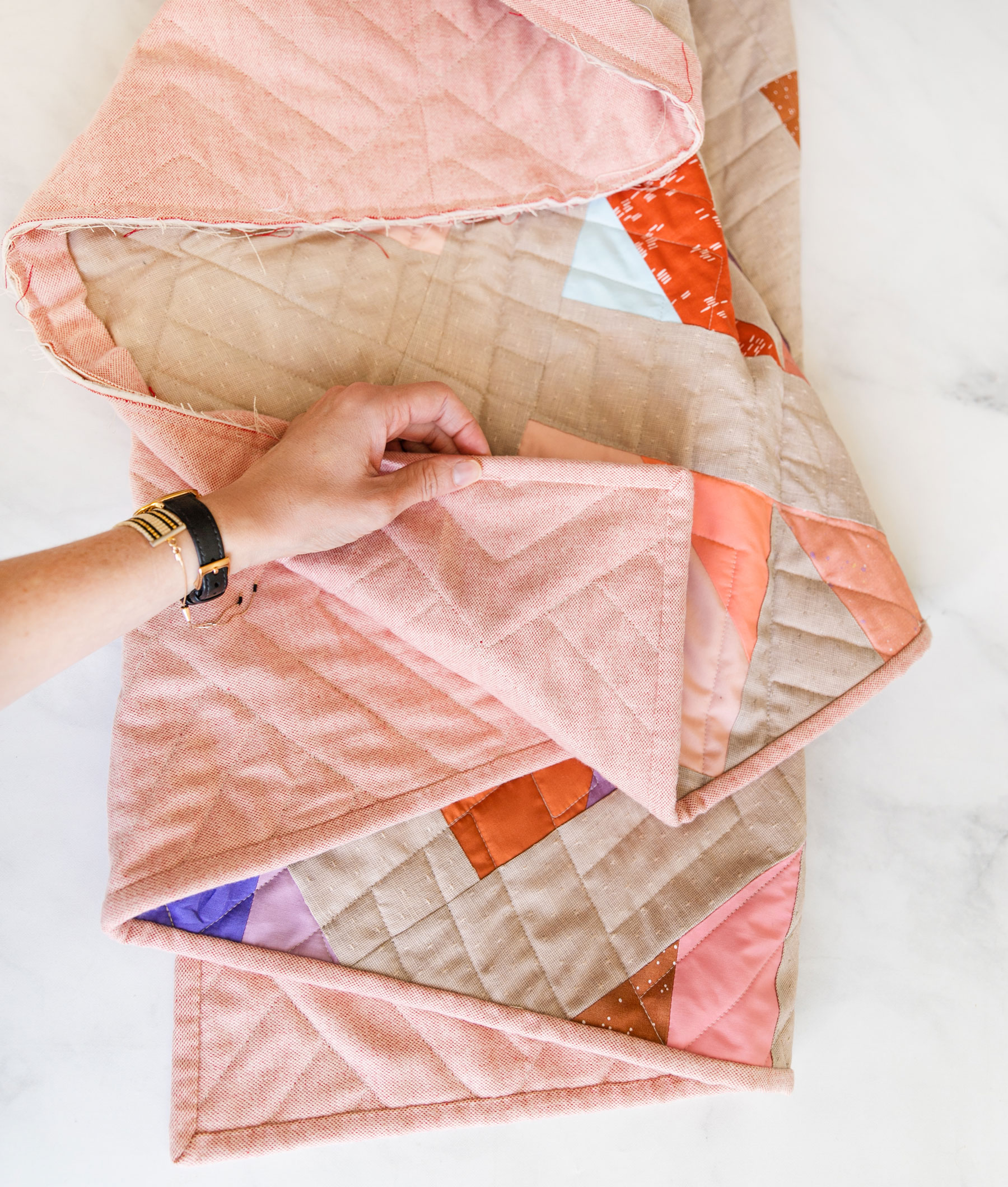
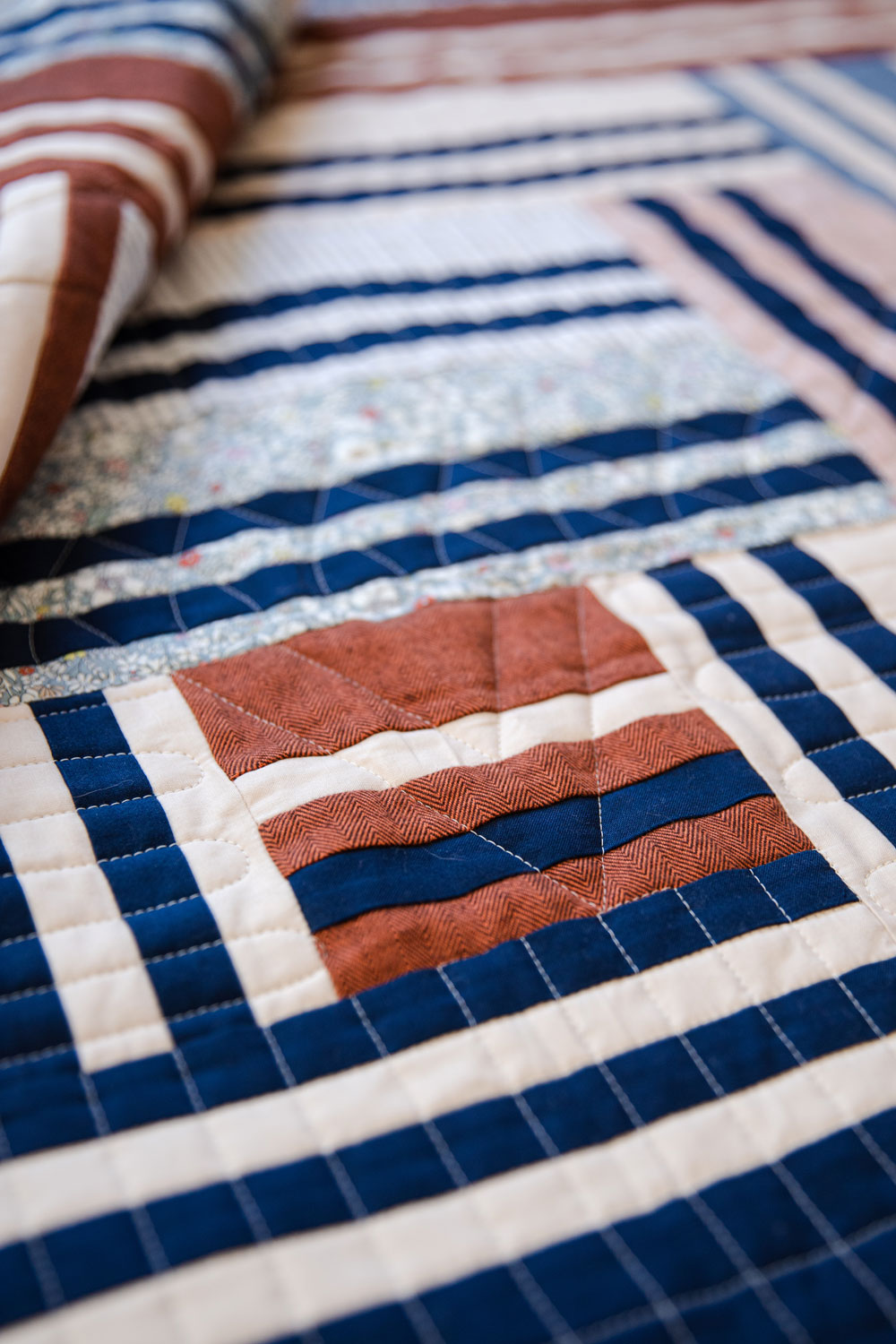



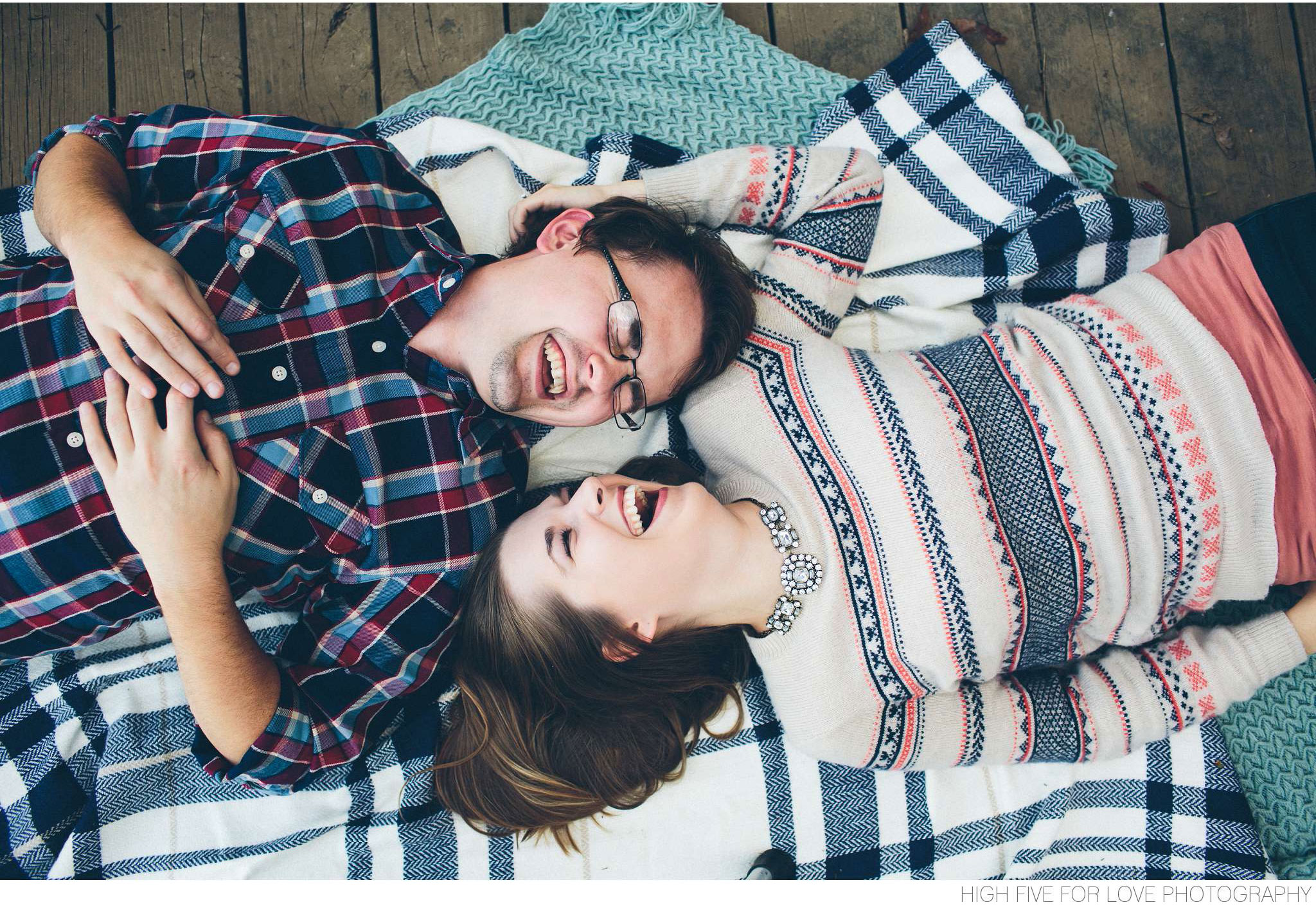
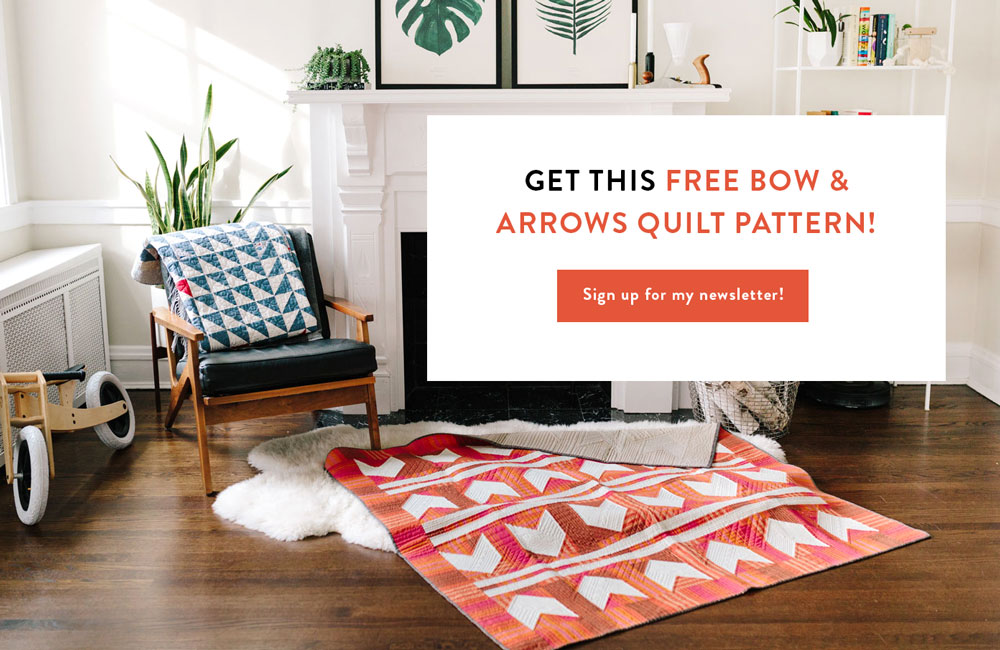
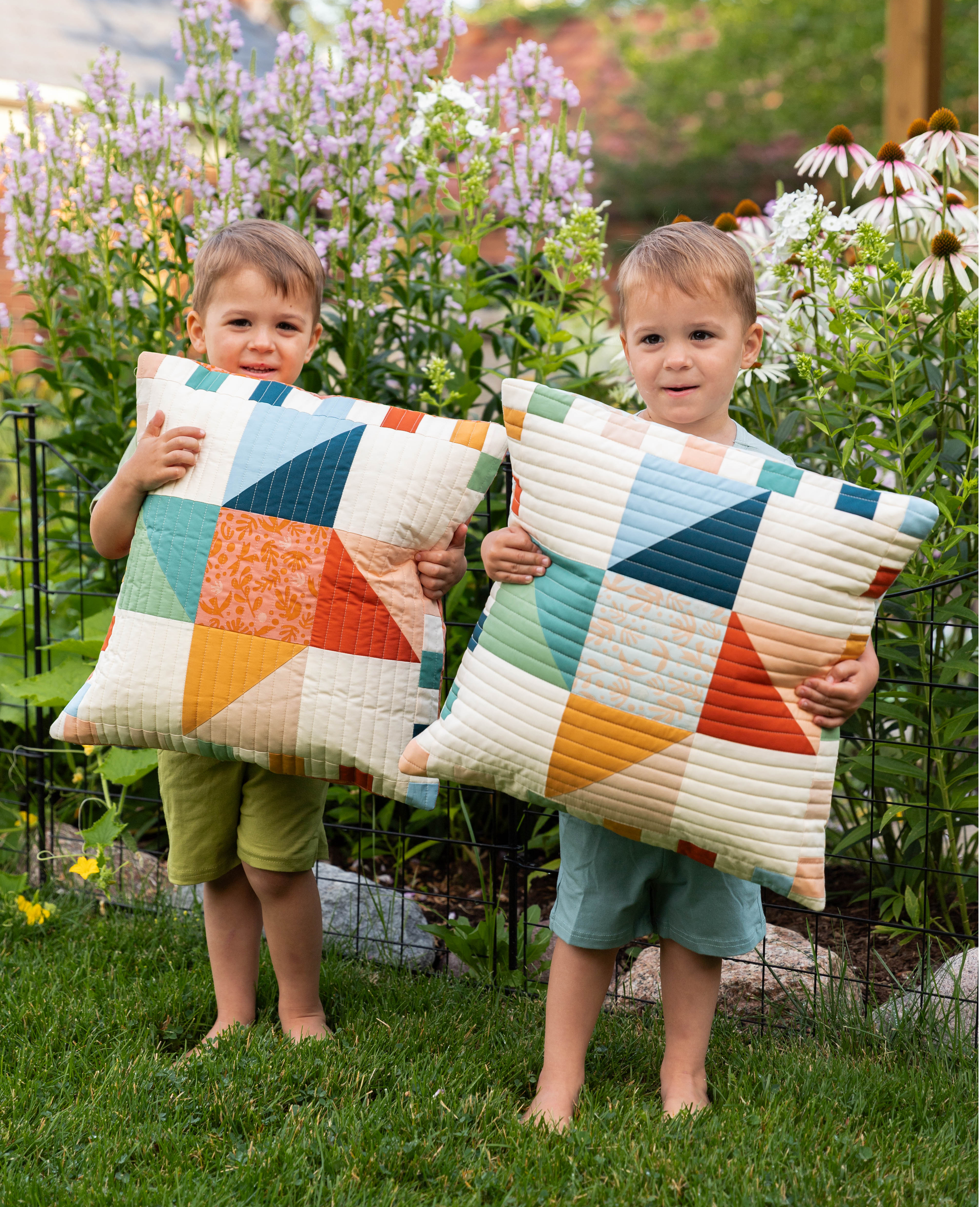

I’m fairly new to reading your blog, and I’m really loving it; the inspiration, the tips, and the fabrics…it’s wonderful!
Thank you for the tips, above, on quilting (or even just sewing, in general) with flannel. Are the photos of your personal stash? If so, I’m curious to know where I can find the flannel in the top photo. The grey windowpane plaid with the pink (?) detail.
One more question: is there a way to discern flannel quality when shopping online? Obviously, if the seller lists the thread count it’s simple. However, I find that many don’t list thread count, and there doesn’t seem to be any terminology associated with it; it seems kind of hit or miss unless you’re buying a designer brand that you can trust.
Thanks again!
Great questions! To answer the first one about the fabric featured, it’s all from Purl Soho. If you click on any of those photos, aside from the main image, it will take you to the specific site to buy. It is true about not knowing flannel thread count from online descriptions. When I shop for fabric, and not just flannel, I typically frequent the same quality places because I know they only carry quality fabric. A local quilt shop is a great place to start. However, if you prefer to shop online, here is a list I compiled of quality fabric shops, Purl Soho being one of them. Good luck, happy sewing and let me know if I can help in any other way! xo
I’m starting a flannel quilt, but noticed as I’m cutting that the plaids go wonky pretty quick. Any tips for cutting squares without wasting fabric so the plaids don’t go off kilter?
hmmm…well some of that might just happen and it’s not your fault – flannel is super stretchy. However, if you are a perfectionist and the off-kilter plaids are going to bug you, I would suggest marking guide marks with a ruler and chalk pencil, then cutting with sharp fabric scissors – that way you can have more control making the cuts straight with the plaid rather than cutting strips with a rotary cutter.
I’ve found using a lightweight, tear-away stabilizer can help keep it from being so stretchy during sewing. However, then you have to take care not to stretch it when tearing away the stabilizer.
YIKES!!! I just stumbled upon this aaaah-may-ZING post. . .and I have a quilt basted and ready to go but i DID NOT PRE-WASH. . . 🙁 I’m a little freaking out because it’s a gift for my brother and I’m worried about what will happen when I wash it!! Am I doomed. . .say it aint so??!!
You are soooooo totally not doomed. Just never wash it!
haha I’m kidding I’m kidding 😉 After the quilt is finished don’t wash it. Give it to your brother and then two years later when he gets around to washing it he’ll think he’s the one who ruined it.
haha I’m totally kidding again!
OK OK, when you/your brother wash it be prepared for it to shrink and pucker HOWEVER a lot of quilters choose not to pre-wash intentionally because it gives the quilt more texture and can make it look more “antique.” It’s aaaaall good. That quilt is going to be used, loved and appreciated. Promise.
THANK YOU THANK YOU!!! especially for the laughs haha. . .i actually don’t mind the second idea, he a bachelor so him NOT washing it for two years is probably more accurate than not baaahaha.
Six years later, this exchange made me snort—thrice. I wish I knew how long it took for the brother to wash (and disintegrate?) the quilt. (After many cozy nights, I’m sure!)
Hi! I just got my first flannel baby quilt for our first Great Granddaughter back from the quilter. It is adorable, but I have been a little worried about some info I got at the quilt store I purchased the fabric from. The older woman said to be sure to machine stitch the binding on, as baby quilts are washed so much that hand stitching wouldn’t hold up well. I, of course, machine stitch the first side of the binding on, but always hand stitch binding on the front side. What is your take o this issue?
I understand the woman’s point, however if you keep your hand stitching small and precise, it will hold up. I’ve never had my quilt binding fall apart and I usually whipstitch it down by hand too. If you’re worried, though, machine stitching binding can look great and is also very secure. You can see in my latest Instagram post that I machine stitched both sides of the binding down.
Love your post. Thanks so much for all the great info on backing with flannel. My question is, do I still need to add batting when using flannel as a back?
Techniquely, I don’t think you would need batting. However, if you want to add some thickness and warmth to the quilt, you will probably want to.
What batting would you recommend? I’d like to keep my flannel quilt fluffy and not have it stiff as a board when it’s finished (I’m not planning on a lot of quilting once it’s pieced to help prevent stiffness).
Thank you!
I have a lot of batting info here if you want to check it out – https://suzyquilts.com/how-to-choose-the-right-quilt-batting/
To get a soft drape right out of the bag, I would recommend a poly blend or bamboo batting. However, the more you wash any quilt, the more the drape will loosen up. Also, the density of your quilting will make a big difference on the quilt’s initial stiffness. More quilting = stiffer. Less quilting = loose drape.
Should you add an iron-on interfacing on a flannel quilt block?
If working with quality flannel, that’s not necessary.
Is there a thread that you recommend for quilting on flannel?
I wrote a blog post about choosing the right thread for the job – check it out! https://suzyquilts.com/best-quality-sewing-thread/
I don’t quilt with flannel. However, I am machine-quilting a flannel-backed quilt for a friend, and I find that it is very hard work to free-motion this quilt. It requires “”man-handling”, even though I have a “Supreme Slider” on the bed of my sewing machine. Naturally, my free-motion work is suffering from not being able to glide this quilt smoothly. I am using a domestic machine. Do you have any advice?
Hmmmm…are you using quilting gloves? I find those to be infinitely helpful when quilting. You don’t have to exert as much energy when moving the quilt around.
I use quilting gloves. I also put flannel-backed tablecloths (plastic side up) on the tables surrounding my machine. (This is a tip from Sue Patten; I took a couple of classes from her in Toronto in June.) The vinyl/plastic tablecloth idea is a great idea to use when doing any machine quilting on a domestic machine.
Since writing my query to you, I’ve raised my free-motion foot a bit and changed to a smaller needle (to Quilting 11 from Topstitch 14), and those changes have helped. But quilting a flannel backed quilt is way more difficult than a cotton or silk backing, so I’m pretty sure I won’t be quilting flannel again…:)
Great information. I’m new to your site and have already learned so much. I back all my quilts with flannel as I like that cozy feel on one side of the quilt. Since I have not yet had the courage to try free motion, all my quilts have been stitch-in-the-ditch or something equally simple. Maxine’s post was interesting and something I will keep in mind should I ever take the plunge to free motion. I did recently make a quilt using a flannel charm pack and found out just want you mean about flannel stretching!
I made a ridiculously oversized jean patchwork quilt with flannel backing and no batting. (I hate playing blanket tug of war with my hubby and two dogs, and the thing kind of just kept growing.) It’s so wide it actually won’t fit on the long arm. We sewed the flannel backing on and added a chambray binding.
Since we can’t quilt, my options are to hand tie or stitch in ditch. (I think my preference is stitch in ditch as I’m imagining one of our dogs chewing on hand ties.) I’m looking for thoughts on really how much tacking of front to back I need to do since there is no batting. Do I need to do every seam or just a few or is it needed since no batting? Appreciate your thoughts!
A big reason we quilt stitches close together is so the batting doesn’t travel. Since you don’t have batting, the only reason you need to stitch the two layers together is so the remain relatively together without becoming a ballooning duvet cover. Maybe try sewing every 12″ and see if that’s enough for you?
I’ve been asked to make a memory quilt using flannel shirts. Some of the flannel is heavier than others. Should I use an iron on backing to make them more even in weight?
That isn’t necessary for piecing the quilt top. Once you baste and quilt it together, you won’t notice the differences in weights.
If the fabric manufacturer says wash cold would you still crank up the heat? Prewashing to back a quilt. My washing machine is super basic and just has cold warm or hot – no temperatures!
I’ve seen some people say to use a Sharps needle instead of a Quilting needle. I am quilting 2 pieces of good quality prewashed flannel with some white & warm batting sandwiched between. I am doing simple wavy lines.
Just a quick note. The sewing machine repair people caution to never use compressed air. It forces the fuzz deeper into the machine and also can cause rusting. Use a small vacuum instead.
That’s what I had been told too. Wanted to comment but saw yours…
I too am trying to make a memory quilt out of flannel shirts. I made simple 9 patch blocks and now don’t know what kind of backing I should use. Also going to try to long arm quilt it.
You could keep the good times rolling with more flannel! 🙂
I know this is 7 years on, but I want to say to those of you making the memory quilts “Bless you”. We joked that my father had a “uniform” that consisted of flannel shirts tucked into jeans with a leather belt and sneakers. He wore this every day, except in summer when he switched to a polo shirt tucked in instead. When he passed away, I asked a friend to make several small quilts from his many flannel shirts, and I gifted one to each of my siblings and one to my mother. We all love our “Dad Quilts” and they have pride of place in all of our homes. My mother was buried with hers after a short battle with Alzheimer’s Disease. I cuddle under mine to watch TV all the time. The memory of my father makes me that much warmer. I would not have been able to sew these quilts myself at the time, between caring for Mom, health issues of my own, and lack of experience. The gift of my friend’s skill was an incredible blessing, and I’m sure that the recipients of your quilts will feel the same. (BTW, I paid her for her time and effort as well. She didn’t ask for payment, but if you’ve taken the time and effort to learn a skill I have not, you deserve compensation for using that skill on my behalf!)
I just stumbled upon this site and freaking out as well. I have the flannel top of the quilt for my soon coming grand baby. I was looking for pointers on finishing up with the fleece backing. Finding out about fleece not shrinking and flannel shrinking a ton. What should I do now??
Hi Donna, don’t fret! You’re grandson will love this cozy quilt. It sounds dreamy! If you didn’t pre-wash your fabric before sewing, your quilt will experience some “puckering” once it’s washed. That shouldn’t effect the integrity of the quilt, it will simply look a bit more antiqued. To reduce the shrinkage as much as possible, once your quilt is complete, wash it in cold water. This article on washing and caring for quilts might help – https://suzyquilts.com/wash-and-care-for-a-quilt/
Good luck!
Suzy, your wit and humour makes me giggle to no end! I am new to this quilting lifestyle, boy oh boy, do you ever make it easy to jump in and get my feet mucky! (Metaphorically speaking of course, my cozy socks and fancy tea mugs have never felt more at home sitting still at the machine while I rip out stitches and ignore the dogs for hours). Thank you for all of your incredible suggestions and guidance, this 28-year old sure does love a good incomplete dating profile reference!
The plaid flannels are not created eqaul and really depends on the manufacturer. I have some sitting on my ironing board as wee speak about to start a quilt- but with large blocks. Baby flannel is a breeze to sew with but will stretch so keep your iron on a lower heat- and don’t pull- press, don’t iron. The larger plaid, you need to cut it on the stripes- many are loaded and get twisted on the bolt- another good way to determine a good tight one from the lesser- they take more care in the loading of the bolts. It also makes it stiffer and feels different. Going to appliqué on top of the flannel instead of trying to use small patches for the blocks. Will see how it works out. TGhanks for the tips
Hi
Just completed my first rag baby quilt, used flannel fabric, I must say it looks great, I washed the quilt but don’t have a dryer, but it still came out looking pretty good, one problem I have all these lose threads from the fraying, no matter how many times I shake the quilt, i keep getting more and more, concern is for the baby
This may be a frustrating answer, but you probably need to just keep shaking it and pulling at the raw edges until it stops shedding. Eventually it will…it just might take a while. You could try washing it again. I bet that would loosen up some threads.
Be sure to put an old panty hose stocking or knee high hose/stocking on the washer drain hose. Attach tightly with large rubber bands. You’ll save having to call a plumber to unplug your drain!
Great suggestion!
I am planning flannel rag quilts for my small grandchildren. I don’t want them to be too heavy for them to carry around…will 2 layers of flannel work instead of 3?
I think so 🙂
When piecing a flannel quilt should the seams be pressed open or to the side? Is it ok to use steam or is a dry iron preferable?
Pressing seams open or to the side is really just a personal preference. I like to press to the side just because I think seams are more stable that way. Steam is totally fine as long as you have pre-washed your flannel.
I’m getting ready to start my first flannel quilt and was wondering if a light-weight interfacing could be used to stabilize the flannel, to reduce the stretching problem. Has anyone out there tried this or is it a bad idea?
Interfacing shouldn’t be necessary. If you’re worried about stretching, you could spray it with starch. Here’s more on that – https://suzyquilts.com/starch-quilt-fabric/
What’s the best way to find a flannel that won’t pill; is it price alone?
Trial and error works well! Start by purchasing a small amount of a flannel you like and test it out before buying all the yardage you need. You can wash it and rub it to see if it starts to pill. If it does, try another brand!
I quilted with flannel and now noticed there was some stretch while I was quilting…..should I take it all out and redo it? Or will it be inconspicuous after it’s washed again? 🙁 I’m nervous and sad.
I’m so sorry you’re not happy with the quilting. I know the feeling and it can be disappointing. Some of that might be due to your basting. I’m not a fan of ripping stitches unless the quilt is an absolute disaster – which is sounds like it’s not. I suggest leaving it as is and starting a new project. Chances are once you come back to it a few days later, you won’t see the same “imperfections” you are seeing now. Good luck!
How should I cut my flannel? Parallel to the salvage or the other way or does it even matter?
Great question! If you cut parallel to the selvage, or lengthwise, your flannel will have little to no stretch. However, if you cut as you normally would when cutting for a quilt – with the selvages together and crosswise, it will have a bit more stretch. Assuming you are cutting your flannel for pieces in a quilt, eventually they will be trimmed on all sides. So, the very long answer is – it doesn’t really matter. I supposed I could have led with that…haha! 😉
I have learned a few tricks that have helped me piecing flannel.
1. If I am piecing flannel with equal sized squares, I mark the cut edge of one side of the square with a tiny short line that runs parallel to the selvage so I can tell which edge is the un-stretchy direction. I use disappearing pen (the blue, not purple).
2. When I piece the squares together to make a ROW I stitch all pieces going along the un-stretchy edge.
3. Then finger press each seam in the ROW in the same direction. Next row is finger pressed in the opposite direction.
4. Now when attaching row to row they should nest into the seams of the row above them PLUS because this row of stitching is the stretchy edges together they ease together nicely at the parallel seams. I usually only pin where the seams nest together ALWAYS at a 45* angle making it easier to ensure seams meet up nicely.
5. I usually press these seams open.
6. To avoid stretching the pieced squares I don’t use an iron until I have 4 rows… this size not too big to cause a drag while draping fabric on the ironing board. And I am less tempted to move the iron back and forth, which prevents stretching. I piece sets of 4 rows next.
Great tips – thank you!!!
I just made a T-shirt quilt for my granddaughter’s graduation present. She wanted it soft and snuggly, so I did things a little different than I usually do for a T-shirt quilt. I used featherweight stabilizer, Warm and Natural batting, and backed it with flannel. It’s at the quilter’s now………….AND…………..I’m reading that I should have preshrunk the flannel backing! It’s a hot pink snuggle flannel from JoAnn’s, and we love it. Tell me it will be OK. I love the old fashioned puckered look, but I just don’t want the quilt to be too out of square after it’s washed.
Mary, it’s going to be OK. 🙂 My guess is that your longarm quilter will quilt close enough together that even if your quilt wanted to shrink up and get wacky it wouldn’t be able to. More good news is that it will shrink uniformly, so if squared corners are your concern, you should be just fine. Your granddaughter is going to love it!
Oh, thank you so much. I can sleep tonight!
Hi Suzy,
I am making a quilt using a pieced top with a flannel back and no batting. The flannel is a sheet from Garnet Hill, so I’m hoping good-ish quality. If I shrink the flannel sheet, what will happen when I wash the finished quilt and the pieced top shrinks but the flannel backing doesn’t?
No matter what, if you don’t prewash all of your fabric, you will have some level of shrinkage once it’s washed, causing the vintage crinkle effect. Flannel, however, will shrink even more than regular quilt-weight cotton, so it’s still a good idea to wash it before using. Check out my post on prewashing fabric for more on that – https://suzyquilts.com/should-you-prewash-fabric-before-quilting/
I bought a flannel panel for a baby quilt. I did not wash it. I got ready to quilt doing free motion around some of the figures starting in the center . Using a 90/14. immediately experienced puckering. Noticed uneven stitching. increased the stitch length but had difficulty with sliding. Took out the machine stitching and decided to hand quilt around pattern in the center. Ready to put this in file 13 and do something different. Thinking about cross hatching the whole panel.
Is it possible that the quilt sandwich wasn’t basted well enough? Thought could be the reason for the puckering. Flannel is also not an easy fabric to free-motion. You probably will have more luck hand quilting.
I am quilting a baby quilt using a precut 5″ flannel charm pack. To keep it from stretching while piecing it together, should the fabric grain go in a certain direction? (all going across in horizontal rows or all going up in a vertical rows?) Or should I not worry about the grain and just starch the fabric? Thanks!
I wouldn’t worry so much about grain. Your charm pack is probably cut pretty closely to the grain of the fabric already, so all you need now is a bit of starch. Good luck!
How do you make a small quilt with cotton pieced front and flannel backing? Anything I need to do other than prewash the flannel? Should I use cotton fabric or flannel to bind it? Thanks. I am a newbie toquilting in general but no experience with flannel
Prewashing your flannel is a good start. You can use flannel for the binding, however since you are new to quilting, I would recommend using your regular quilt-weight cotton, since that will be easier to work with. By only advice is to baste your quilt sandwich really well and if you are machine quilting, use a walking foot and sew slowly.
Do you have any advice on basting the flannel? I just finished piecing a photo quilt for my niece’s wedding and am working with a flannel backing for the first time. I started and then ripped because I didn’t get the back straight and flat enough. At least now I can prewash and maybe starch will help. Any other ideas?
When it comes to using flannel, I would use the same basting process as if I were using any other cotton, linen, or canvas backing – https://suzyquilts.com/how-to-baste-a-quilt/ The most important part in getting a good baste is making sure it’s flat and secured to the floor (or your working surface.)
I use the top of our pool table for all steps of prepping the sandwich and pin basting. For making the sandwich with backing face down first, it is AMAZING how well I can hand smooth each layer before pinning. And no slipping of the fabric. I take care to not snag the felt top of the pool table!
So I’m about to embark on my first ever quilt. This bucket list item is happening. It took a while, but I finally found the cutest pre-cut quilt kit! But… it is flannel! I was going to ask how to pre-wash all of those little pre-cut squares, but after reading your helpful article and comments, I’m thinking maybe I shouldn’t do this flannel set I found. Should I let the flannel go and continue my search for an easier quilt kit? Thanks for your help!
If you have a cute pre-cut flannel bundle I’d hate to see it go unused. You can still sew with it, just be aware that it will shrink a lot and look quite different once it’s washed. I also recommend washing it in cold water and fluff drying in your machine or air drying to prevent massive shrinkage.
Do you wash it before adding the batting and backing fabric or after it’s finished?
After it’s completely finished with no raw edges showing.
Hello, I’m new to quilting but have wanted to make a flannel quilt for some time. I love all of your tips on this subject and am so glad I stumbled across your site before diving in! I have never tried free motion quilting but I’m not sure I would ever attempt it on flannel now that I have read all the questions and comments. Would it be okay to straight line a flannel patchwork quilt? I plan on using a good quality flannel for this project.
Straight line quilting is a great idea! Good luck 🙂
I have just completed a lap size flannel quilt top. I usually wash the quilt once completed, but I am thinking about cotton backing and thought perhaps I would wash the quilt top in cold and machine dry BEFORE backing and batting and binding. Your thoughts? I would either baste the outside of the quilt top OR put it in a lingerie bag or pillow case for washing.
Even though the flannel might shrink a bit more than regular cotton, I still think it would be safer to finish the entire quilt, bind it, and then wash it in cold water. Fluff drying or hang drying would prevent a lot of the shrinking too.
I never prewash anything, even flannel ( quilting for 35 years now).The other thing would be to add a cup of vinegar to the wash water- it sets the color. I use vinegar in all my wash for a number of reasons and it does not harm fabric in any way ( even if poured directly on the fabric). It makes colors brighter and prevents the greying of black. If you are really concerned about color running, also add a Color Catcher sheet,
I am making a t-shirt quilt. I have purchased a JoAnn fabric Snuggle brand Plaid flannel, 42″ wide, for the backing. The plaid is wonky. I wanted to use 42″x90″ in the center, then cut a 42″ in piece in half(21″) and seam to the center piece on each side., to avoid a center seam. I can’t match it up and am very frustrated. Any idea what I can do to make it look decent? I know, I know, “buy a solid, not plaid.”
The plaid should be woven on grain, so in theory, if you rip it rather than cut it, the design should get back on track. You may end up losing inches in the process, though.
I bought flannel fat quarter bundles to make a simple quilt for my grandson. Should I prewash them and if so what is the best way to do that? Hand wash?
I don’t recommend pre-washing precut fabric as small or smaller than a fat quarter. You will end up losing too much do to fraying and quilt patterns that require fat quarters may not work with the new shrunken piece of fabric.
Ok so I recently took up quilting and started with flannel. Apparently that wasn’t a good idea? I am on my third baby quilt right now. My first one turned out great even though I didn’t know you had to prewash until now. The second have me a horrible time with gathering at the ends of the lines. I have only done stitch in the ditch so far but for this one I want to hand quilt it with a cute design. Unfortunately I have not prepared any of these quilts, I’m very bad about doing research and just went off what my mother in law has told me not thinking about she only does cotton quilts. I have four grandbabies 1 year and younger, and I’m not that old lol. So, for my question can I hand quilt this flannel quilt without getting all the gathering and making it look cheap and crappy? Trust me this quilt is anything but cheap, to me anyways. Please help, I’m so messed up at this point I don’t know what to do. I almost have the top put together and as much work as I have already put into it I don’t want to have to go repurchase the fabric and start all over. Thank you in advance
Hand quilting or even tying a quilt can be a great way to avoid fabric pulling and gathering. Sometimes machine quilting can cause that because of uneven pulling with the foot and feed dogs. Another way to avoid gathering when machine quilting is to baste your quilt sandwich really really well.
I plan to buy a high quality flannel layer cake to make a quilt. What can I do to prevent shrinking after the quilt is made to prevent future shrinking? Do you recommend pre-shrinking pre-cut layer cake flannel?
Thank you and Merry Christmas
Prewashing precuts is usually on my No-No list because of how much of the precut you can lose due to shrinking and fraying. If you’re following a pattern that assumes you will have the entire precut, don’t do it. However, if you are able to lose a couple inches from each precut, prewashing flannel is a good idea. You could sew a loose basting stitch around the perimeter of each one to prevent some of the fraying. That will get tedious, though, so do that only if you have the time. I’ve tried pinking the edges with pinking shears before and that didn’t seam to help at all.
Once your quilt is finished, wash on a gentle cycle using cold water and lay it flat on a bed of towels to dry. Heat from the washer and drying are going to be the culprits of major shrinking.
I have made several flannel baby quilts, some prewashed…some not. to help keep the seams from pulling apart, I use a long curvy, zigzag stitch down the border seams. I use a high loft batting and since I hate hand work, I cut out several sizes (12 inches down to 3 inches across) paper hearts, pin around them every 2 inches or so and then sew around about 1/2 inch away from the heart using the same curvy stitch (it’s stitch #4 on my Bernina Virtuoso 153) and I use 4.5 for the stitch width and 2 for the stitch length)…never puckers or bunches on the underside. Adds a little love from Grandma. I also hate wonky corners so I trace a quarter circle in each corner when sewing the 3 layers together (I birth my quilts instead of binding) and I clip the round corners and when I turn them they are very smooth.
After turning them right side out, I do a fancy zigzag around the edges and this “closes” the opening and makes the edges stronger.
Hi Suzy, I’ve been quilting for about 10 years now . Learning as I go, A couple years back I made a t shirt quilt for a grandson. I believe I used 1/4 inch seams. The flannel that was holding the t shirts together is pulling apart. It was a lot of work to do this quilt . I’m not sure how to fix it. Thanks for your input
I’m sure it was a lot of work! I think at this point the best thing you can do is mend any areas that have fully pulled apart and then switch to hand washing the quilt rather than machine washing it. Also wash it as infrequently as possible – once a year is not crazy.
Suzy, I bought some flannel backing and tore it selvedge to selvedge, and the piece came out 6 inches wider one one edge than the other ! What went wrong?
Sounds like when it was cut from the bolt it was cut pretty severely off grain. Big box stories like fabric.com and Joanne are notorious for doing this. So annoying. If purchasing from those stores, it’s a good idea to tack on at least a 1/4 yd. to account for this happening.
so what tips do you have for using flannel (2 layers) for batting of a baby quilt. I am making it very plan with kantha stitching or pearl stitching and i am having the hardest time getting my needle in and out of the layers of fabric. to the point i’m ready to hang it up and go buy different batting. but i’m 5 rows in and really don’t want to. I have tried different needles (i’m using embroidery thread) but nothing is making this easier. If i find a needle that pulls the thick thread through it won’t push through good and if i get a needle that goes through the fabric decent then it won’t pull the thread through. aahaahahahah please help or maybe it could be the spray adhesive i don’t know
Hmmmm….I see your dilemma. The issue with using flannel rather than batting is that flannel is made up of threads woven together – so the needle and thread need to push their way between those threads. If you stack two pieces of flannel together as the batting you are now making your needle push through four layers of fabric. Batting would be easier because it’s not woven together, but bonded or pressed – allowing the needle a smoother time passing through and many more points of entry. Does that make sense?
Unfortunately, I think your options are to switch to a thinner, sharper needle and thinner thread (probably a traditional quilting thread that is wax coated) or to switch to just one layer of flannel or light batting. If it’s the drape of flannel you are after, bamboo batting can give you something similar – especially after washing.
Is it possible to combine flannel and woven cotton fabric in a quilt top?
It is, I would just prewash everything first.
Hi, thank you for your tutorials and very helpful videos! On the flannel batting subject… I am making a baby quilt (my first) and used flannel for the top pieces as well as the batting and linen as the back. I’m hand quilting it because I like the look of hand quilting, but will my knots be more likely to pull through? They just don’t seem that secure. And thanks in advance fur your thoughts!
That’s a great question. One reason batting works well when hand quilting is the thread knots get knotted into the fibers and made more secure over time. With flannel you would have that; however I think if you always double knot your thread and maybe even use a thinner thread, like 12 wt., you will be OK.
You would wash some of the half meter cotton as well?
I have a mystery quilt that went terribly wrong. I don’t want to put much more work into it so I plan on tying it and using flannel instead of batting. How far apart can I tie it? The top and back are 100% cotton quilting fabric. Thank you
You could probably get away with every 8″ apart.
Thanks for all the info…really helped. I have a BIG concern still re washing my rag quilt and getting the drain clogged up. Any feedback would be appreciated. Thank you.
You could try using a washing machine bag to keep those extra threads confined.
I made a t-shirt quilt with flannel sashing, borders, and backing. I’m ready to do the binding. I was told to cut 2-1/2″ strips for double binding. Being a newbie, can you tell me whether to cut the binding strips selvage-to-selvage or parallel to the selvage? Thank you for your help.
I suggest cutting them selvage to selvage. Fold the fabric in half, lining up the selvages, lay the fabric on your cutting mat and cut that way. Here’s a post on binding – https://suzyquilts.com/how-to-sew-binding-on-a-quilt/
I just bought four 1-yard pieces of flannel at a high quality fabric store. It was so soft and yummy I couldn’t resist. I’ve never sewn with flannel before so I read this post. I have made several quilts and considering myself an advanced quilter. Can you recommend a pattern that works well with flannel? Something to show off the plaid, and in larger pieces? I don’t want to cut the flannel into tons of little pieces. Thanks!
I think the new Reflections pattern would be perfect in flannel!
Thanks! I’ll check it out
I’m using flannel in my summer quilt for batting. The blocks are 11” between sashing which I have already straight line machine quilted. Is 11” too far apart? Do I need to add more quilting? The flannel was prewashed, several times.
Great question! Because you are using flannel instead of batting, you do not run the risk of batting bunching, shifting or collecting in lumps underneath your quilt sandwich. The flannel layer does not need as much stabilizing as a layer of batting, so what you have quilted is enough.
Hello. I am making my daughter a baby blanket for my newest grandson arriving in October. I am using a flannel panel with Luxe Cuddle Minky. In the above post you mentioned that you do not recommend starching one fabric and not the other. Can minky even be starched? I am new to sewing anything let alone quilting and blanket making! I guess if I am jumping in I might as well go head first LOL. Anyway I would like to starch the flannel as I know that it stretches, but what do I do with the minky? Thanks in advance for any advice!
Hmmm…good question. I don’t recommend starching minky…in fact, I bet if you did, it wouldn’t do much good. In this scenario, I think you could hold off on the starch and still be OK. Both fabrics are going to be a bit shifty, but as long as you’re not aiming for perfection, it will work out beautifully and be incredibly cuddly. If you haven’t seen this tutorial, it’s written especially for minky and flannel would be a perfect companion fabric.
In the article, you recommend using a 1/2 inch inseam rather than 1/4. So, when I cut the fabric, do I increase ALL measurements by 1/4. For example, when the instructions say to cut 3 1/2 x 8 1/2 ” rectangles, I would cut 3 3/4 x 8 3/4 ” Correct? I know this is a pretty basic question but want to get it right! Thanks!
Great question! If you want to increase your seam allowance by 1/4″ all around, you would need to add 1/2″ to the cut size. Using your example, you would cut 4″ x 9″ strips.
Thank you! After thinking about it, I came to the conclusion I would need to add 1/2 inch all around, so glad I was right!
I wish I would have read this post before I started on my flannel quilt. I can definitely say that the suggestion about 1/2″ seam would have been a smart way to go and saved me a lot of grief–I had lots of issues with the fraying, and on a few occasions when the stitching got too close to the edge of one layer I seamed together, it needed to be ripped, and that was a disaster. It required some creative work to get it fixed, since I couldn’t redo it for several reasons: I was out of one of the fabrics so couldn’t redo; it was already nearly done (sewing rows together). The walking foot is also a good suggestion, and I’ll be using it once I get ready to do the quilting (I’m almost there). I also had cutting challenges because the fabric likes to move while the rotary cutter is rolling along; that was very frustrating and sometimes left a ruffled cut. Fortunately, I did think to prewash in very hot water to get the bleeding and shrinking out of the way. To add to the overall problem, this is my first quilt! And I have one more to do in flannel since I already purchased the fabric, but I’ll be making changes on how I do it, and your suggestions should make things easier. Also, it’s worth mentioning that the fabric in solid colors I bought from a big box store, was really poor quality, which was especially obvious after purchasing some better quality from a quilt store to replace the solids in my second project. The prints from the box store seemed to be better, though, for some reason. Thanks for your post!
Just starting a flannel quilt and found your article. Such helpful advice. Thank you!
I’m using some cheaper flannel to back my quilt but I’m having problems machine quilting it. The quilt isn’t feeding well into my machine, the only way it will is if I push the quilt through but even then the stitches are super tiny regardless of what stitch length I’m using. The feed dogs are also sort of tearing up the flannel 😫 I’m using a walking foot and quilting gloves so I’m not sure what else to do. Do you have any suggestions for how I can machine quilt this?
It could be a thread issue. Are you using 100% cotton thread? Poly thread can sometimes cut through flannel and cause tension issues. If you post this question to the Suzy Quilts Patterns Facebook group, along with the make and model of your sewing machine, others will have great suggestions for you.
Will keep all this in mind when trading the quilts. I particularly like your suggestion with flannel.
Should the binding strips be cut wider when working with flannel? I did the 1/2 inch seam allowance on the quilt. Just wondering if it is necessary to do wider binding strips because of fraying, etc. Used a lot of your suggestions of working with flannel and think it helped!!
I’m glad to hear that! Yes, cut your binding strips wider too. Flannel is thicker than regular lightweight cotton, so when it’s doubled up and folded over an edge, it gets thicker and needs to be wider so it can have room to fully cover the raw edge completely.
Dear Suzy!
What a helpfull blog! But I have still some questions and I’m hoping you can help…
I want to make the Peppermint lane quilt from the It’s sew Emma book and purchased the Vintage holiday fat quarter bundle by Bonnie and Camille. But: it is flannel… For the background I have Bella solids cotton. (white)
Can I do this? Sew “mixed” blocks with flannel and cotton?
Thanks for your help and best regards from Hamburg!
Great question! Very rarely will I respond to that question with a “No.” Can you do that? Totally! Back in the day fabric was fabric and “light-weight quilting cotton” did not exist. It was the wild wild west of sewing because in fact it was the wild wild west! haha!
Anyway, I’m not answering your question very well. Yes, you can sew flannel to quilting cotton. I would recommend prewashing, though. I’m breaking my own prewashing rules by telling your to prewash precuts, but this is different because the two fabrics will shrink differently. So, to prevent all kinds of crazy fraying in the wash, sew a zig-zag stitch around the perimeter of each FQ before washing.
Stick with a 1/4″ seam listed in the pattern so the math doesn’t get confusing. Since you’ve prewashed the worst of the unraveling has already happened. Good luck!
Dear Suzy! I would like to thank you for your great tips for my Bonnie and Camille Flannel Quilt! And here comes the update: I’ve sewed the edges of two fat quarters with the zig zag stich and then prewashed them And what can I say? They have shrunk from 18×21 inch to 17,5×21 inch (Yay!) Today I sewed the first block and it turned out great. Again a thousand thanks and best regards from Hamburg from Julia (happy)
I’m trying to whip up a quick (fingers crossed) wholecloth baby quilt for a dear friend: flannel front, flannel backing, flannel binding… Is this a terrible idea? Is using an 80-20 poly blend batting because I’ve prewashed the flannels kosher??? I just can’t manage to cut and piece and quilt and bind for a baby that is already a month old. Done is better than perfect, right?
This is a great idea! My only suggestion (if you weren’t already going to do this) is to cut your binding strips at least 2 1/2″ thick. Flannel binding is wonderful, but because it’s a little thick when folded, you need the strips to be a bit wider so that the raw edges of the quilt are fully covered.
Hello Suzy,
Forgive me if you have answered this question in the post above. When binding a flannel quilt, would I allow for a 1/2 inch seam allowance? i.e, should I cut my binding strips 3 inches instead of 2.5?
Thanks in advance.
If your binding is also flannel, that’s a good idea. If you are using regular quilting cotton, 2.5″ or even 2.75″ would be enough. Just make sure your seam allowance is wider when sewing your binding strips to the quilt so that when you fold the binding over it is the same size on both sides.
I’m thinking of using a wool batting for a bed quilt I’ve pieced for our mountain cabin (where the only heat is a fireplace). I was planning on using flannel for the backing to maximize the warmth factor, however I’m worried about bearding. Have you ever mixed wool with flannel and noticed bearding? Or is flannel more likely to beard in general? Thanks for any advice!
So here’s my two cents on those two fibers – wool has a reputation for bearding, however if you use high quality wool batting (like Quilters Dream wool) you shouldn’t have that problem. The same goes with flannel. If you use cheap flannel, it may pill after a while. Pilling is easier to deal with than bearding, though, because with pilling you can actually get one of those sweater razors and literally shave your fabric. It works well too! Bearding happens when fibers from your batting migrate to the outer fabric through its weave. That can be hard to fix.
I suggest that you spend the extra money on high quality materials and then enjoy your finished cozy warm quilt!
I will be making a quilt that will have both flannel and quilter’s cotton on the pieced side. Should I use some interfacing to help stabilize the flannel so that it doesn’t shrink or stretch since the quilter’s cotton won’t have as much give? I also though about putting interfacing along the entire back of the pieced side of the quilt once it has been put together to help it all stay well. Just curious if using interfacing in any way could help the quilt become more uniform and wear out less. If so, do you recommend a lightweight or medium weight interfacing?
Thank you!
Interfacing isn’t necessary, but you do want to prewash all of your fabric and use a full 1/4″ seam allowance – not a scant 1/4″.
I am about to start my first flannel quilt and am ready to pre wash the fabric. If I stitch along the edge of the cut line, will that help more with the fraying? I was thinking of doing a overcast stitch.
I think so!
Your information about handling and sewing with flannel are very interesting. Thank you so much. I have stored a lot of different flannels and wool fabric I will use together. But I hate to prewash my fabrics. The shrinking is a big problem. I cut pieces about 10×10 cm and wash them all together. Later I measure and see the differences. I know which fabric shrunks the most. I can start to sew without starch because the new fabrics are easier to sew.
Oops. I pieced a flannel quilt top without prewashing because it was precut squares. I also did not prewash the backing. Before I sandwich it with the batting, should I prewash the top and backing? I am planning on hand quilting it with purl cotton and big stitches….kantha style. Thank you.
Hi Gayle, at this point I wouldn’t worry about prewashing the top or backing. Once you have the quilt completed and bound, wash it in cold water on a gentle cycle. If possible, tumble dry or let it air dry. As much as you can, keep it away from hot water and heat drying. It’s going to be so soft and cuddly!!
Thanks for your blog Suzy. Learnt so much here while my porridge is cooking! I am about to make a doggy coat and I wondered which side of the flannellete was up and after reading about cheap flannel and its tendency to pill and spill onto your machine, I think I will make it upside down and have the fluffy bit on the inside… as I just want the plaid look and a little bit of Spring warmth for my dog – hence it will be a 2 ply with lining and not a 3 ply with wadding. So thanks heaps for your tips. I will look out a new needle, use a longer stitch and sew wider seams. Thanks again.
Hello. I’m getting ready to make my husband a quilt from a flannel layer cake. My question is what is the best fabric to back it with? More flannel? He is always really cold (even though we live in Florida) so I want it to be plenty warm. Also should I include batting to help with the warmth? Thank you for your help.
I’m gonna say yes to both! Use more cozy flannel for the backing and most definitely use batting. If you want it to be extra extra warm, try wool! https://suzyquilts.com/why-wool-batting-makes-the-warmest-quilts/
LOVE your sense of humor!! Definitely a woman after my own heart! Will be using a beautiful dusky rose flannel to back a nap quilt for my bestie. Am hesitant to use a ton of starch on the flannel. In your experience does the starch come out of the fabric once the finished quilt is washed? Also, I’ve pre-washed the flannel on hot. What temperature would the finished quilt be washed at? Many thanks!
Thank you, Dorothy! Starch will wash out of the fabric completely once you are fully finished and send the quilt through the washing machine. I recommend washing finished quilts in cold water on a gentle cycle. Here are a couple links that should help – https://suzyquilts.com/wash-and-care-for-a-quilt/ and https://suzyquilts.com/how-to-care-for-your-new-quilt/
Hi Suzy! I am also so pleasantly surprised with your blog. I am very much a beginner quilter and whenever I have a question, your blog is the first place I look!
I am about to begin a flannel quilt – top and backing both flannel. I ordered a FQ bundle that I love! (Woolies Flannel by Bonnie Sullivan). But it is exactly the right number of FQs that I need for the pattern (Lucky Log Cabins by Quilty Love). Therefore, I don’t think I will have much extra. Will flannel shrink enough that I might be short fabric?
Also, is pre-washing necessary if both the backing and the quilt top are flannel?
Finally, do you have a recommended batting for flannel quilts? I was so drawn to wool after reading your blog (this quilt will be a gift for a family member), but perhaps there is a better option when the shrinkage is considered? Wondering if a flannel + 100% cotton batting + flannel quilt sandwich would all shrink nicely together? WWSQD!? (What would Suzy Quilts do?) Thanks in advance!!
Thanks, Mallory! Flannel FQs are tricky, because yes, flannel does shrink a lot, and yes, flannel can fray a lot, so typically I would say that you need to prewash your flannels. However, since you are dealing with precuts, I probably wouldn’t prewash, just make sure you are sewing with at least a 1/4″ seam allowance. No scant 1/4″. Hopefully the pattern allows for that. Also, only wash your quilt in cold water.
Since you are not prewashing the FQs, you don’t need to prewash the flannel backing unless you are worried the dye will bleed. Almost all batting sold these days comes prewashed and “preshrunk.” It will still experience some shrinking, but not a huge amount. Flannel pairs well with any batting and since you won’t be washing this quilt with hot water, wool is still a great option!
Hi Suzy and Mallory,
I just stumbled onto this website today, looking to see how big a seam allowance to use when piecing two large pieces of background fabric for an appliqués quilt top. (In case you know the answer.)
Well, I have a flannel dilemma: I have started piecing a hybrid quilt top of flannel and quilting cotton. It’s a scrabble quilt and the squares are cut at about 3”x3.5”. I bought Woolies flannel ten squares, bc it looks like suede, for the background squares. Since they are pre cuts, I don’t see how I could wash them bc they’d turn into a ravely mess and if they shrink more than a 1/4”, I won’t be able to get enough squares out of them. I haven’t cut the flannel yet, and only have started piecing the words.
Mallory, how did your quilt turn out? And did the woolies shrink very much? I couldn’t find an answer to this bf I purchased mine. Did the colors run?
I spent a lot of money on fabric for this quilt and I don’t want to ruin it. Suzy, should I reconsider using the Woolies for the background? I also bought a cotton print roll up in matching colors for the backing. The sizes are gonna be tight to make it all fit. I was really looking forward to this and was going to use needle punched cotton batting. Will it work out or become a terrible mess? 😬What should I do?
Thank you both for any and all input. I really appreciate it. 🌷
HI, Suzy. Thanks for all of this great information. I didn’t see anything about paper piecing with flannel. Do you think this will be problematic? Do you have any suggestions? Thanks so much.
Hi Suzy, Thanks for sharing your knowledge.
I’m planning a quilt for my dad made with a Woolies flannel layer cake. Are there some patterns that should be avoided when using flannel? I would love to make a Hunters star, but it will mean a lot of sewing on bias edges. I’ve not worked with quality flannel before, but my cheap flannel test bed is quite bumpy and stretchy. Wondering if I should re-think the pattern…
Flannel does best when used as large pieces. Because it’s pretty thick stuff, sewing lots of seams will add bulk and take away from its general coziness. My favorite way to use flannel is as quilt backing!
Thank you for this! I just backed a cotton quilt with flannel and realized to my dismay that the pattern was upside down. After sleeping on it (not literally LOL) I think I dodged a bullet because I had NOT prewashed the flannel. So…I am off to buy cotton backing fabric. Anyone need a massive flannel back? I think this is the equivalent of going to the washroom after the appetizer course and sneaking out a window. HA! but… also thank you!
I really hope I am asking the right question BUT I am making my 1st flannel quilted baby blanket. The front is 9 squares of 9? Basically 81 4.5 x 4.5 squares and the back is 1 solid fleece. My weird question is this: What should I do to make the blanket “stay together and not bunch up? Do I make long stitches across and diagonal? Help me please? Lol Thank you in advance for your time and consideration on my dilemma.
Yes, to keep your layers together you will need to add some quilting. You can do this through simple quilt ties, machine quilting or hand quilting. I have tutorials on all three if you do a search on the blog.
OMG! I`am so happy I stumbled onto your site. I made two baby bibs out of quiting cotton and flannel. I never worked with flannel. Something told me to look up flannel fabric. I almost had a heart attack that I did not pre-treat the flannel. Thank goodness the ones I made are only samples! Last night, I pre-washed and dried all the flannel I had. I`am going to Joann’s fabric to get some of your recommended starch!. I would not want to have anyone disappointed with their gifts! Thank you so much for posting this important information.
Hi Suzy! I am making a patchwork quilt from my son’s old flannel swaddling blankets. I pieced the squares together by hand. I used flannel for the backing and low-loft polyester batting. I am hand-quilting the blanket. (I’m getting mentally prepared for the hand work out!) Would 20wt quilting thread be appropriate, or should I go thicker? And what length stitch would you recommend? Since this is my first quilt, I’m just going to “stitch in the ditch.” Thanks for any help!
I have a great tutorial for you – https://suzyquilts.com/how-to-hand-quilt/ In this I use thicker thread, but 20 wt. would be just fine.
What type of thread is best for top stitching a flannel quilt (both front and back)? When choosing the color of the thread, if you have three main colors, which works best? A light neutral gray or one of the bolder colors? Thanks for a great collection of tips!
My rule of thumb with thread is to pair natural fibers with natural fibers. (See The Difference Between Cotton and Poly Thread)Since your flannel is made from a natural fiber, cotton thread or a poly blend would be best. There is no “right” or “wrong” thread color choice, but I personally like to match my thread to the lightest color of fabric in the quilt. I also highly suggest not using really dark thread like black on light fabric. That can look like medical stitches and I’m sure you don’t want that.
This is a very informative post, thanks Suzy! I am looking for a flannel for a design wall (actually it’ll be on a roller blind that is mounted to a door frame as I have No wall space). I came across the term “2 ply”. What does this refer to? I’ll need a wide back size in a white/neutral colour and will have to order online as I have no shops nearby so it’ll be hard no to be able to ‘feel’ it, AND I’m in Canada :(. Any suggestions? Thanks!
I don’t hear about 2-ply flannel very often, but I would assume that it’s extra thick since the 2-ply refers to two yarns twisted together into a thread before woven into fabric. You can purchase wide flannel specifically for this purpose. Fons and Porter has a product like that. Robert Kaufman is a manufacturer that makes nice quality flannel. If you look online and find something you like from them it will be nice. Another option is to use a thin cotton batting instead of flannel. Check out this article if you haven’t already – https://suzyquilts.com/how-to-make-quilt-design-wall/
I believe kaffe fassett has a flannel grid fabric that is intended to be used for design walls!
I don’t think I’ve told you lately how much I appreciate all your info. I am so glad I read this before trying the Maypole in flannel. I will cut everything with the extra space for that 1/2 inch seam allowance, so smart ! I’m off to wash my flannel fabrics! Yay! (And do a few more HSTs for the Holiday Party quilt)
That’s wonderful! Your doggies will love their quilts 😉
This is not much help, but there are different grades of flannel, and brands may be more dependable, but I do know that those called double flannel (nap on both sides is wonderful, but very heavy. Good luck!
Can I use flannel as a backing for a “regular” cotton quilted front? Or would I be flirting with disaster? I’m making my first grandchild’s baby quilt and came across an adorable print I fell in love with, but it’s flannel. And probably not high quality. I found it at Hobby Lobby. Your thoughts?
As long as you prewash flannel, it should be ok! Flannel tends to shrink more than other fabrics, so making sure to prewash your fabric before piecing will be very important so that the top and back don’t shrink at different rates once you’ve finished the quilt 🙂
I’m about to embark on my first flannel quilt(s?) using Maywood Little Lambies for one, and Maywood Stormy Seas for the other (precuts: 10″ layer cake & charm squares for each). I was initially planning to make 2 quilts, but now I wonder if I could make 2 flannel quilt tops and have the long-arm quilter quilt them together to be used as a reversible quilt? If so, could I perhaps use muslin between the layers instead of actual batting so the finished quilt isn’t too heavy? Any suggestions would be appreciated!!
I am starting a quilt using Maywood’s Woollies Flannel 2.5 x WOF fabric strips. Although the conventional rule is not to pre-shrink precut flannel, I did a test. To minimize the fraying, I zigzag stitched very close to the edges of each strip (2.5 width and 1.5 length stitch). I then soaked the strips in very hot water (no visible colour bleed) and dried them at the hottest temperature in my drier. The result: virtually no fraying, the WOF shrunk by 2 inches, but the 2.5 width stayed true. There was a marked change in the colours, which I prefer: more blended, darker than pre-wash.
Although this process will add significant prep time, it gives me confidence that I can use the pre-cuts without future issues of shrinkage or bleeding, or having to use a 1/2 inch seam allowance.
Hi Suzy, Like so many others, I stumbled across your site and boy am I glad I did! you have so much good information on here. I am making a quilt for my dear friend to take with her to chemo. She said it’s very cold in the treatment room. I pieced a cotton top and plan to use flannel on the back. I
wanted to know your opinion on what batting would be warm and work well with the two fabrics? I also learned I should pre-wash the flannel so that is helpful! I had ordered some 80/20 batting as recommended by my local quilt shop but will that work with the shrinkage factor? And will it be warm enough?
What a wonderful gift. Wool is a great choice you could also look into! Here’s a blog post that should really help: https://suzyquilts.com/why-wool-batting-makes-the-warmest-quilts/
While working in a fabric shop during a Shop Hop and elderly lady brought in a flannel quilt to be quilted. Her blocks consisted of HSTs and were perfectly stitched. I asked her how in the world was she able to piece that quilt so nicely. She gave me a wink, leaned in and whispered, I glued the corners together before stitching!!! The word What was swimming around in my mouth and threating to spill out over my tongue. I composed myself and asked more questions. Yes, she takes a small dot of water soluble glue (Elmers School Glue) on the corners of her blocks and gently presses before stitching the HSTS together. Storing the information in the back of my mind, I decided to attempt a flannel quilt call Scrapenstance. Nervous at first and thinking to myself I’m going to ruin my machine, I decided to try it. It works. The pressing dries the glue and it washes out of the fabric in the first wash. She made me a believer, and IF I ever decide to ever make another flannel quilt I will make it the same way.
Amazing!
Making a flannel baby quilt. It has flannel appliques; having trouble with zig-zag attaching the appliques (my machine is old-no other attaching features on my 1974 Kenmore). Zig-zag works fine on cotton. Since 2015 I’ve made 15 quilts–all cotton–this is my first flannel. The appliques are first stuck to background fabric with adhesive mesh, then I have all sorts of problems with the zig-zag when sewing around applique edges. Is it possible to back the appliques with a cotton fabric–maybe this would help? Maybe I’m your first male quilter.
Hi Dan! First off, there are lots of male quilters, who make Suzy Quilts patterns! We’re big fans of all quilters 🙂 Because you noted that your machine is older, have you tried brinigng it in to be serviced and asking at your local shop? It could be more of an issue with the machine that the material. That would be a nice starting point!
I have made a couple of quilts and now working on my first flannel quilt. Do I need to use interfacing on the quilt top to keep it from fraying? The quilt top is a random pattern and I did not pre wash the fabric. any suggestions would be greatly appreciated. Thank you
I don’t think interfacing is necessary. Since you didn’t prewash the fabric, I recommend opting for denser quilting to keep all of the seams secure. Sounds cuddly!
Thank you for the most thorough article on quilting with flannel. I purchased fat quarters to make burp cloths for my grandchild to be. My son and his wife preferred the gauze type (they are soft, wash easily and dry faster). I repurposed the flannel into a quilt and am just ready to do the binding. Your article has been so helpful.
Your quilting, colour choices are just beautiful. Thanks again